This was published 4 months ago
Master or monster: The artist equally loathed and revered
Call it charisma, presence or personal magnetism, Paul Gauguin had it in abundance.
Paul Gauguin was both master and monster. This was the view of the French writer Victor Segalen who arrived in the Marquesas to make an inventory of the late artist’s belongings. In the excellent catalogue for Gauguin’s World: Tōna Iho, Tōna Ao, at the National Gallery of Australia, two essayists remind us of Segalen’s verdict, which was no simple term of abuse. Instead of calling Gauguin (1848-1903) a “monster”, today we might say he was a “freak”, or a defiantly unorthodox character who stood out from every crowd.
No other great artist has such a chequered reputation, not even Picasso, whose every move has been scrutinised by hostile biographers. Those who knew Gauguin either revered or loathed him, although he was skilled at turning followers into enemies.
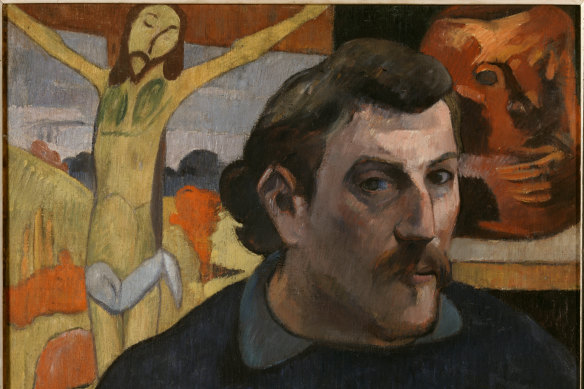
Self-portrait with the Yellow Christ, 1890–91.Credit: Musée d’Orsay, Paris
The Australian artist John Russell would refer to “that bounder, Gauguin”, and wonder why his friend Vincent van Gogh rated him so highly. Monet dismissed the artist as a clumsy amateur, but Degas, the most prickly of the impressionists, was a major collector of Gauguin’s work. Call it charisma, presence or personal magnetism, Gauguin had it in abundance. He brazenly identified with Jesus Christ in his self-portraits, and many of his friends might more accurately be called apostles, until at least, like Émile Bernard or Charles Laval, they fell out.
In his writings, Gauguin worked hard at creating an image of himself as a “savage”, a man outside a corrupt, bourgeois society who felt nothing but contempt for its norms. It may sound boorish and self-aggrandising, but he followed through on his claims by living in Tahiti and then the Marquesas, at the furthest remove from Paris and its cosmopolitan attractions.
Gauguin’s World: Tōna Iho, Tōna Ao claims to be the first major exhibition to look at the artist’s work from the perspective of the Pacific. The curator is Henri Loyrette, former director of the Louvre and the Musée d’Orsay, who was also responsible for the great Degas exhibition held at the National Gallery of Victoria in 2016. For the NGA and the touring agency Art Exhibitions Australia, the importance of this show can’t be overstated.
We’ve been waiting a long time for Gauguin. Of all modern masters, he has the best claims to be seen and appreciated in this part of the world, being the only one to have lived and worked in Oceania. When Matisse travelled to Tahiti in 1930, it was to follow in Gauguin’s footsteps, but he found it almost impossible to paint anything. It would take him years to find an outlet for his experiences in the late cut-outs.
Aside from adding Tahitian words to the title of the exhibition, the NGA has collaborated with Polynesian scholars including Vaiana Giraud and Miriama Bono, and sponsored a satellite event by contemporary Polynesian art collective the SaVĀge K’lub. The aim is to recalibrate our view of an artist that even Prime Minister Anthony Albanese, in opening the show, called “problematic”.
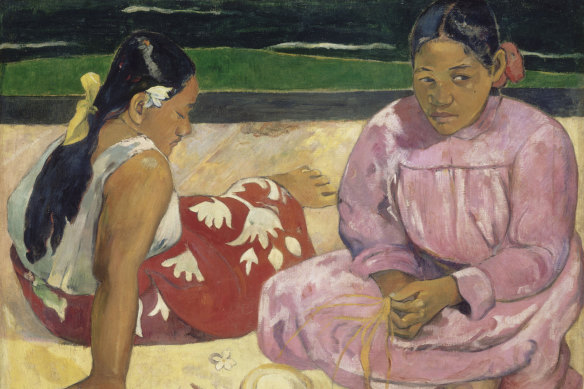
Paul Gauguin’s Tahitian women (Femmes de Tahiti), 1891.
The provocative words by which Gauguin advertised his own “monstrosity” have become a liability in a hypersensitive age, when many prefer to cancel rather than study an artist. It’s almost too easy to say Gauguin was a sexual predator, a misogynist, a colonialist, a cultural appropriator. He freely admits his relations with teenage Tahitian girls, aged 13-15, and speaks of the native people in terms that can sound patronising.
If this provides a reason to turn in revulsion from the man and his art, it’s also the height of intellectual nullity, and ultimately, a caricature. Feminist scholar Norma Broude argues that it’s hard to square the “misogynist” Gauguin with his outspoken views on women’s emancipation, in which he echoes his grandmother, the radical activist Flora Tristan (1803-44). It’s equally difficult to see him as a colonialist when he campaigned tirelessly against the corruption of the colonial administration and the hypocrisy of the church in both Tahiti and the Marquesas.
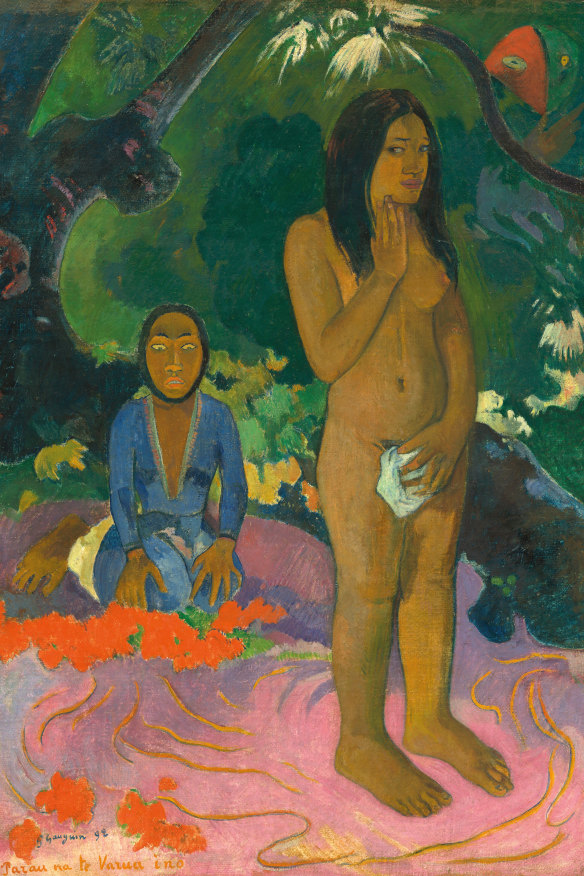
Paul Gauguin’s Parau na te varua ino (Words of the devil), 1892.Credit: National Gallery of Art, Washington, D.C
With Gauguin, the good and the bad must be seen through the lens of his extreme egotism. The autobiographical impulse is constant in his work, even in a late arrangement of objects and flowers, Still Life with Hope (1901). The “hope” refers to a postcard of a famous work of 1872 by Puvis de Chavannes. The still life features a Tahitian bowl and a bunch of faded sunflowers, paying a cryptic tribute to his tragic friend Vincent. Puvis hoped for an era of peace following the Franco-Prussian war; Gauguin may have hoped for a happier life in the tropics, or some respite from the painful memories of his years in France.
The artist’s arrival in Tahiti, as recounted in his book Noa Noa (1901), echoes the romantic descriptions of Pierre Loti, a bestselling author whom one can only read with discomfort today. In The Marriage of Loti (1880), the lead character enjoys social success in Papeete, whereas Gauguin – the eternal pariah – breaks with his literary predecessor and glories in his status as an outsider.
In claiming to be a “savage”, Gauguin was expressing a deep desire to free himself from the chains of “polite” society. His commitment to artistic experimentation was so profound he despised those who worked to a fixed set of rules – even self-imposed disciplines such as the massed dots of the pointillists that seduced his one-time mentor Camille Pissarro.
Most tellingly, Gauguin had a lifelong obsession with religion. He draws continually on his Catholic heritage, even when writing diatribes against the church. He is fascinated by Buddhism and by the traditional religious beliefs of Polynesia that the missionaries sought to eradicate. He may be an unashamed sensualist, but he is also a seeker after spiritual knowledge. For Pissarro, even the works Gauguin made in Brittany had seemed dangerously “mystical”.
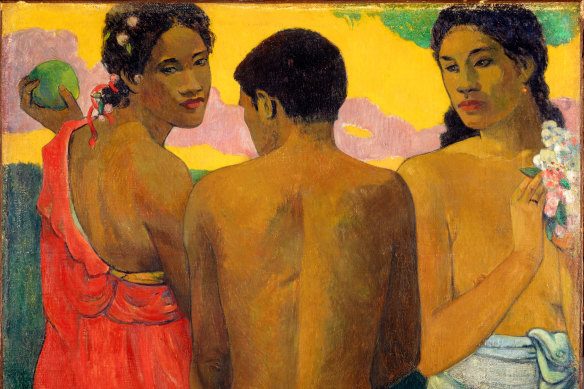
Paul Gauguin’s painting Three Tahitians, 1899.Credit: National Galleries of Scotland, Edinburgh
Although this exhibition puts its greatest emphasis on the Polynesian works, made during 1891-93, and 1895-1903, it covers the full sweep of this self-taught artist’s career, from an early landscape of 1873 to the paintings left in the studio at his death. It includes prints, drawings, sculptures, ceramics and carvings, as well as a range of tribal artefacts that served as inspiration or subject matter. In every medium, Gauguin was a relentless innovator, ready to steal ideas and techniques from anywhere and adapt them to his own purposes.
Loyrette shows deference to Gauguin’s egocentrism by starting the exhibition with a room of self-portraits. The first is Portrait of the Artist with the Yellow Christ (1890-91), in which he portrays himself between two of his works – a painting of a crude, Breton crucifix and a grotesque piece of pottery that bears his own features. He literally puts himself between God and the devil, looking calm and confident in his powers.
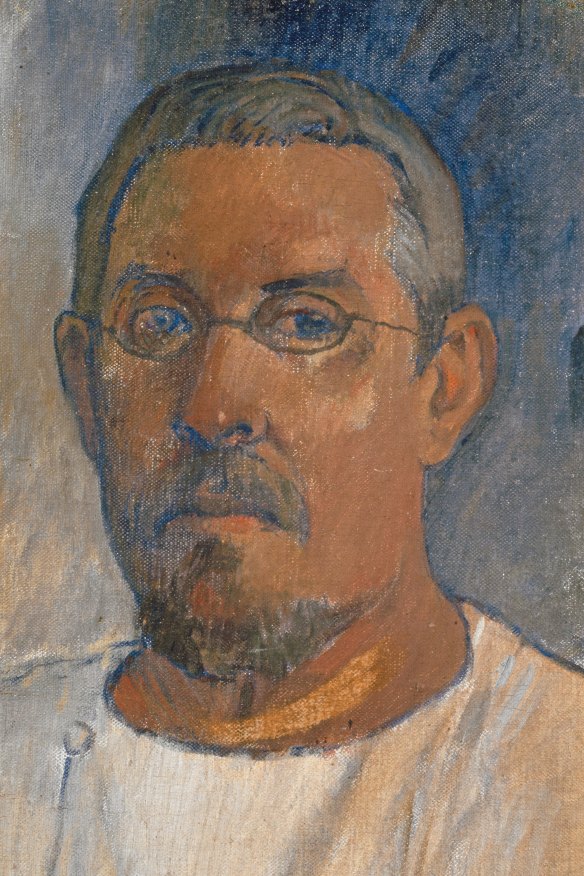
Paul Gauguin’s Portrait of the artist by himself, 1903.
This sense of theatricality, which distinguishes many of the early self-portraits, is swept aside by Self-portrait (near Golgotha) (1896), made in Polynesia at a time when Gauguin was so sick and poor that he contemplated suicide. The artist’s face has filled out and his eyes have grown dull. He wears a simple white smock, like a patient in hospital or a prisoner facing execution. A final self-portrait, the thinly painted Portrait of the artist by himself (1903), is even more chilling in its honesty. It shows the ageing artist with spectacles, short, grey hair and trimmed beard. Facing death, he wears a placid expression. Picasso’s final self-portrait was filled with terror, but Gauguin shows us a man who has come to terms with his own extinction.
These self-portraits stay in the mind as we proceed from one gallery to the next, allowing us to discern the vulnerable personality behind those boldly coloured canvases. The show features more than 140 items from 65 different sources, including a dozen or so major paintings. Indisputable masterpieces such as Where do we come from? What are we? Where are we Going (1897-98), Nevermore (1897), or Mana’o tupapa’u (The Spirit of the Dead Watching) (1892), were never going to be allowed to travel to Australia. Yet there are other works that are scarcely less familiar, notably Tahitian Women (1891), from the Musée D’Orsay, Hina tefatou (The Moon and the Earth) (1893), from New York’s Museum of Modern Art, and Three Tahitians (1891), from Edinburgh.
Mana’o tupapa’u is arguably the most regrettable absence because it is the painting Gauguin’s detractors use to portray him in the worst possible light. It is both a homage to Manet’s Olympia (1863) and a kind of parody in which a nude teenage girl lies face down on a couch, watched over by a gloomy spectre rather than a maid. There’s a lot that can be said for and against this painting, with Nicholas Thomas putting the case for the defence in his new book Gauguin and Polynesia.
The particular interest of this book is the author’s extensive, first-hand experience of Polynesia, in opposition to most of Gauguin’s critics who rely on large intellectual assumptions. At the opening of the show, it was fascinating to hear from French Polynesians who saw Gauguin not as a colonial exploiter, but as a figure who respected the islands’ cultural traditions to the extent of giving Tahitian titles to his paintings. There may be no works by Gauguin left in Tahiti or the Marquesas, but his images of the Pacific and its peoples have permeated the global imagination.
As the indigenous peoples of the Pacific strive for a contemporary cultural revival, they are seeing Gauguin’s personal complexities as far less significant than his transcendent, celebratory vision of Polynesian life.
Gauguin’s World: Tōna Iho, Tōna Ao is at the National Gallery of Australia, Canberra until October 7.
John McDonald travelled as a guest of the National Gallery of Australia.
The Booklist is a weekly newsletter for book lovers from books editor Jason Steger. Get it delivered every Friday.